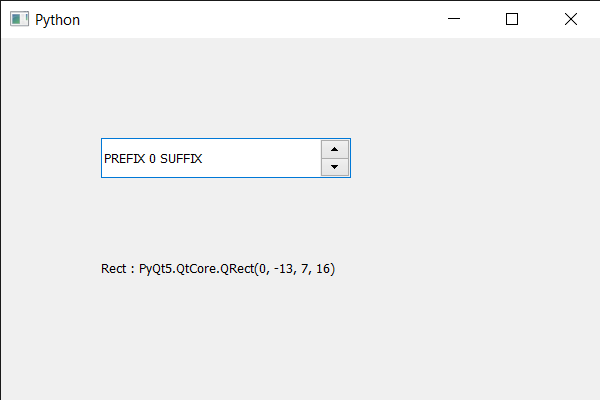En este artículo veremos cómo podemos obtener el rectángulo delimitador del carácter dado del cuadro de número, es decir, el rectángulo que está cubierto por tinta si el carácter ‘ch’ fuera a dibujarse en el origen del sistema de coordenadas. El rectángulo delimitador puede extenderse a la izquierda de (0, 0) (p. ej., para fuentes en cursiva), y la salida de texto puede cubrir todos los píxeles del rectángulo delimitador. Para un carácter de espacio, el rectángulo normalmente estará vacío.
Para hacer esto, usamos boundingRectel método con el objeto QFontMetrics del cuadro de número.
Sintaxis: font_metrics.boundingRect(ch)
Argumento: toma una string como argumento
Return : Devuelve el objeto QRect
Nota: este método también se puede usar para obtener el rectángulo delimitador de todo el texto
A continuación se muestra la implementación.
# importing libraries
from PyQt5.QtWidgets import *
from PyQt5 import QtCore, QtGui
from PyQt5.QtGui import *
from PyQt5.QtCore import *
import sys
class Window(QMainWindow):
def __init__(self):
super().__init__()
# setting title
self.setWindowTitle("Python ")
# setting geometry
self.setGeometry(100, 100, 600, 400)
# calling method
self.UiComponents()
# showing all the widgets
self.show()
# method for widgets
def UiComponents(self):
# creating spin box
self.spin = QSpinBox(self)
# setting geometry to spin box
self.spin.setGeometry(100, 100, 250, 40)
# setting range to the spin box
self.spin.setRange(0, 999999)
# setting prefix to spin
self.spin.setPrefix("PREFIX ")
# setting suffix to spin
self.spin.setSuffix(" SUFFIX")
# creating a label
label = QLabel(self)
# making label multi line
label.setWordWrap(True)
# setting geometry to the label
label.setGeometry(100, 200, 300, 60)
# getting font metrics
f_metrics = self.spin.fontMetrics()
# getting average character width
rec = f_metrics.boundingRect('S')
# setting text to the label
label.setText("Rect : " + str(rec))
# create pyqt5 app
App = QApplication(sys.argv)
# create the instance of our Window
window = Window()
# start the app
sys.exit(App.exec())
Producción :
Publicación traducida automáticamente
Artículo escrito por rakshitarora y traducido por Barcelona Geeks. The original can be accessed here. Licence: CCBY-SA